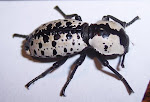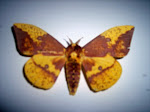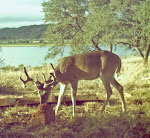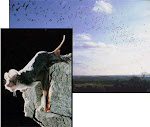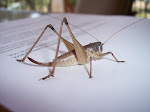Issue 6 - August 28, 2009 Whitetail Deer
Well, good morning and welcome to another day in Paradise! Sun’s coming up and the coffee smells great………
You know, there probably isn’t another animal in the Hill Country that is more well known and cherished than the Whitetail Deer. Deer seem to be a part of our Texas psyche and deeply imbedded in our culture. They have fed and clothed generations of Texans, added immeasurably to our sporting pleasure, and our landscape just wouldn’t be the same without them. There is nothing more majestic than a big buck moving quickly through the hardwoods on a cool morning. There is nothing that will warm your soul more than watching a doe standing over her twin fawns still wet in their spotted coats.
(Kingdom; Animalia, Phylum; Chordata, Class; Mammalia, Order; Artiodactyla, Family; Cervidae, Genus: Odocoileus, Species: O. Virginianus)
The picture above was taken shortly after dawn of a buck in velvet nibbling on a feed block just behind my house. Barbara and Marty (of ‘Walk Like A Man’ fame) probably recognize the photo’s background because it is the same view of the mouth of the Guadalupe that they see when looking south out their back porch.
I’d guess this buck is 3 ½ years old. He’s certainly mature and in the prime of his life, but he doesn’t have the sagging belly, heft, or swayback of a really old buck. It looks to me like he’ll be a nine or ten pointer this year, with long brow tines, when he looses his velvet and his antlers harden. I’d say this one is a typical buck for our area.
I occasionally put out a protein block behind the house to give the deer (and other animals) something nutritious to nibble. Since it’s so blasted hot and dry this year, the forage has been pretty poor for the deer and to me they seem to be thin and stressed. By stressed I mean that I see them out feeding or drinking from the river during the heat of the day, when they should be bedded down in the shade somewhere. Normally I just observe and don’t interfere with Mother Nature, but I figure that a little extra food during this period of drought won’t throw off the cosmic balance.
There are at least fifteen different bucks that come to my yard and feed although they don’t all come every day. I can recognize them as individuals from their horns and, at least here in my part of the Peninsula, I know their social hierarchy. Their social interactions and their displays of dominance, aggression and even affection are fascinating. In addition to the one pictured above, I can distinguish one ten pointer, four eight pointers, four sixes, one five, two four pointers and two spike horns. I haven’t named them yet (but I bet Tom Prosch has names for the ones he hand feeds !?).
The dominant animal on my side of the Peninsula is the heaviest of the eight pointers. He doesn’t have the biggest set of antlers but he is the largest animal and the others clearly defer to him. The most common way they show this deference is to allow him to eat first. He will walk straight in to the feed block and if another deer was on it they will move off about twenty feet or so and mill around until the big boy is finished. Every once in a while, another buck will get too close to the big one and he will posture, stare them down, and sometimes feint a charge. On rare occasions he will rear up and strike out with his front hooves. However, it seems that all the deer know who is boss and don’t really push the issue with old Numero Uno. They give him his space. It is different, however, when lesser bucks of a similar size are the only ones around.
Two of the young six pointers (probably 1 ½ year olds) are well matched physically and act like a couple of teenagers whose older sister just bought them some Corona from Buddys. They poke and prod and push and cavort around trying to act tough with one another. (My mother called it ‘roughhousing’ when it was myself and my two brothers.) No harm is done and it normally turns out that the uphill one wins these shoving matches. None of the other deer pay much attention to them and that probably adds to their frustration. (There is no joy in showing off if the girls aren’t impressed, even for deer.) Later in the year when the rut begins, these two will probably go at it in a much more serious manner.
One young four pointer with lyre shaped antlers can always be seen tagging along behind another of the eight pointers, one who appears quite old and, I believe, injured. This old fellow has gnarly, short antlers and is well past his prime. They are an odd couple and I don’t really understand their bond. It’s almost like the youngster is shadowing the old guy trying to learn from his experience. The ancient eight pointer probably puts up with it because the four pointer is the only one who will listen to his stories over and over again.
There are about twenty does and button bucks in the vicinity too, but I can’t identify more than three or four individuals out of that group. There are a few torn ears and a scar or two but they are difficult to distinguish. There is a big old doe in this group who has two fawns at the moment. She is quite dominant and can hold her own with the bucks as well. I guess you would call her the matriarch of the group. She must be a pretty good mother because her fawns look healthy and raising two young ones during this drought is quite an accomplishment. I often see her early in the morning, along with a younger doe with one fawn, on the Petsch’s new green lawn at the corner of Puzzle Pass and Mystic Blvd. As the crow flies, that’s about five hundred yards from my house. This old doe used to bed down in the shade of the cedars behind the windmill and tank there on Puzzle Pass. Now that construction is starting on that lot, she’ll probably find another bedding area a little farther west. If anything, these whitetail adapt well.
Home range is usually less than a square mile for a whitetail. In these trying times, however, they may range farther in order to find enough food. They are herbivores and normally feed in the early morning and evening hours. Their diet varies a little throughout the year with green plants favored in the spring and summer, acorns and corn in the fall, and buds and twigs from woody plants in the winter.
The whitetail is a ruminant and has a four-chambered stomach for digestion just like a cow. Each chamber has a different function and this allows them to quickly eat a variety of different foods, digesting it at a later time in a safe spot in cover. Yep, a deer chews (actually re-chews) its cud too.
This species is common in the US and Canada east of the Rockies and is found in all but five of the States. Its range extends south through Mexico and Central America and whitetail can even be found in parts of Peru. They have expanded into almost all agricultural areas and also where coniferous forests have been harvested and replaced by deciduous secondary growth. They are generalists and can be found in a wide variety of habitats, from the mountains to the prairies, as the song goes.
The scientists will tell you that the largest deer live in the temperate regions of the US and Canada but they are full of baloney! The Texas deer are the biggest and best, even if they don’t weigh as much and aren’t as tall. (Our average doe is about 90 lbs and average buck only about 140 lb.) At least there won’t be much argument about the size of their antlers because Texas deer are known, worldwide, for their impressive headgear.
These antlers (different from ‘horns’) are re-grown by the males every year. All the bucks drop their antlers between December and February, after all the does are bred. You can often find the ‘sheds’ from the previous year’s antlers in your hikes around Mystic Shores. I’ve found perhaps a dozen sheds in the Peninsula in the past year, but then again I spend a lot of time walking the fields.
Antlers start to grow in the spring underneath a highly vascularized tissue known as velvet. (I saw a buck earlier this year with blood on its face from a damaged velvet sheath.) Normally the bucks are very careful not to damage the velvet as their antlers grow. By the time the females enter estrus (the period called the ‘rut’) the buck’s antlers are fully developed, hard and polished.
Contrary to popular belief, you can not accurately tell the age of a deer by the number of points on their antlers. Genetics and diet are the biggest factors and a yearling (1 ½ year old) buck can often have six or eight point branching antlers.
The rut is normally in late October or early November and is triggered by the declining amount of daylight. The sexual maturation of the females is very much dependant on the population density. This is one way Mother Nature adjusts the numbers and evens things out in good times and bad. It is even possible for a doe to become pregnant in her first year, although this would only occur in extremely low population density situations (certainly not here). Most females mature at 1 year of age and are able to reproduce after another six months. Yearling does often have one fawn while older deer normally have twins in May or June. The fawns, of course, have spots during their first summer which is an adaptation to optimize their camouflage and concealment during this critical period. Fawns reportedly also have minimal scent which also aids them in hiding from predators.
There are few natural predators left to prey on whitetail. Coyotes are probably the biggest threat to our Texas whitetails while cougars and the occasional bear still take their share farther west in the state. However, mature whitetails can outrun coyotes, so they catch mostly the sick and very young. This lack of significant predators is a big factor in the whitetail population explosion and the subsequent overpopulation problems many areas face.
The total population of whitetails in the US is now estimated to be thirty million animals. Texas has the largest population of any state (gospel truth) with about four million whitetails and the Edwards Plateau of Central Texas has the highest population density (gospel truth again).
The deer’s coat is reddish-brown in the spring and summer and turns to a more grayish-brown in the fall and winter. I personally think that there is a variation from animal to animal in coloration that is more pronounced than the seasonal change. Some say that the older deer will have more gray. Regardless, the deer can easily be recognized by the white underside of its tail. This is raised when the deer is alarmed and runs off, and is the source of their common name ‘white-tail’. Often this is the first thing you will notice when you spot a deer as you are walking (or driving) around our neighborhood. The bright white tail bounding through the field really grabs your attention. Raising their tail to show that flash of white is a message to all the deer in sight that there is danger afoot.
Whitetails communicate with one another in other ways too. They have a fantastic sense of smell and scent is all important to them. They have a number of scent glands on their bodies and routinely leave urine and scent markings throughout their territories. Certainly one of the most important messages they convey this way is when the does are receptive for breeding. They also make audible noises to communicate.
Fawns will squeal or bleat if they are looking for mommy and the does will bleat back. Does will grunt to get the attention of other deer and will snort and thump the ground when they sense danger, as will bucks. (The older the buck, the lower the pitch of his grunt.) Aggressive bucks also make a unique noise best described as a ‘grunt-snort-wheeze’ pattern when they are aroused.
The bucks have their own communication scheme going in the fall that helps them find willing females and warn off competing males. They create scent branches (with glands on their foreheads and near their eyes) overhanging scrapes that are checked regularly. These scrapes are cleared areas the bucks paw down to the dirt with their front hooves, and then scent mark with urine that has dribbled over special glands on the inside of their hind legs. Sign-post marks like antler rubs on small trees are often seen in the fall as well.
Once you’ve observed deer for a while, you can also get a feel for how they communicate with their posture and body language. Last fall, my wife and I were walking over on Arthur Ct when a mature buck came out of the brush and began to circle us at about 15 yards. He looked disheveled, had an aggressive stance, and was cocking his head and antlers toward us as if to say ‘You want some of this?’. We quickly moved away and the deer just as quickly lost interest in us. Attacks on people are very rare, but when they do happen, they can be serious. This is the first and only time I’ve personally experienced this kind of behavior. I suspect that the buck had recently lost a fight and was just looking for trouble.
Deer can carry the black-legged (deer) tick, and each year there are Texans who contract tick borne diseases. If you get a rash or flu-like symptoms after being bitten by a tick, you should immediately seek medical attention.
Whitetails can live to be 20 years old but very few live to be half that age. The average lifespan for whitetails is just 2 to 3 years. Why so short? Car accidents take the biggest toll. Just think how many dead deer we see along side of route 306 every week. Deer are constantly being hit by cars, but the ones on the roadside don’t stay there long with turkey vultures and ants acting as our clean up crews. However, those carcasses are the tip of the iceberg because many more deer that we don’t see are hit by cars and escape into the brush before dying of their injuries. It’s a sad reality, but it is one way protein gets efficiently recycled back into the food chain. Plus, we also have the consolation that this is a relative rapid and painless way to adjust the deer population when the numbers are high. Nature’s way through disease and/or starvation is a lot more ruthless.
You know, each and every day I’m here in Mystic Shores I take pleasure in all our creatures, but there is just something special about our deer. Perhaps it is because they are so beautiful and graceful. Perhaps it is because there are a lot of them and, since I see them frequently, they come to mind often.
Or perhaps it is because God decided to put in some extra effort and create the perfect animal to share and enrich our environment…… the whitetail deer.
Clay
Click on these pictures to go directly to the article.
Followers
Blog Archive
About Me

- Clay Crum
- I'm always looking for suggestions (or photos) about other Mystic Shore wildlife. Do you know where a rattlesnake den is located? Do you have pictures of a mountain lion taken locally? Have you had interesting encounters with our wildlife? Share them with me by sending me an email or commenting on this blog.
